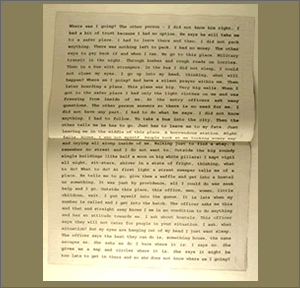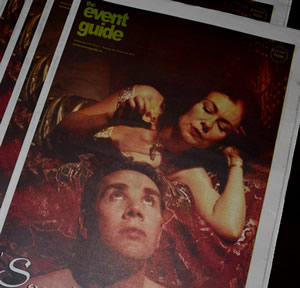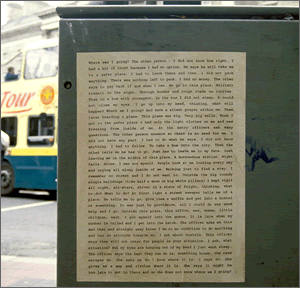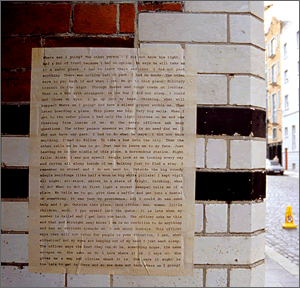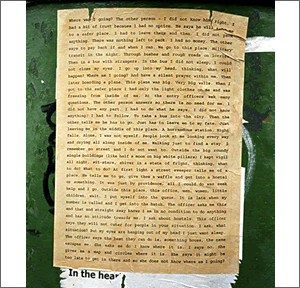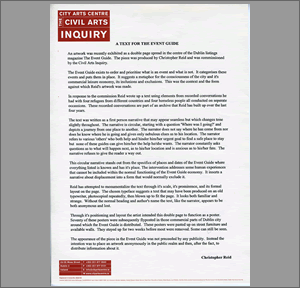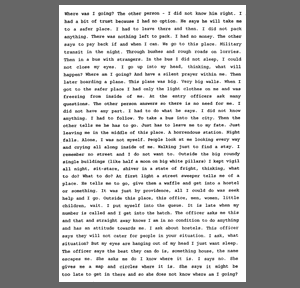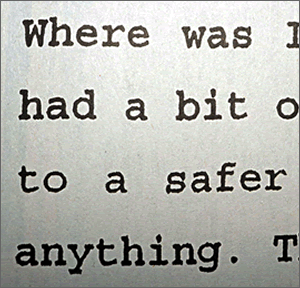2003: A Text for the Event Guide
In this work Chris Reid inserted a typeset composite voice made up of fragments of recordings with 8 separate homeless people into the centre pages of the Dublin Listings magazine ‘The Event Guide’. This voice – a lost voice and the experiences registered in it are monumentalised within the listings magazines theoretically turning this text and it’s context – a specific edition of The Event guide into an artwork.
This artwork was exhibited as a centrefold spread and poster in the centre of the Dublin listings magazine The Event Guide (see fig. 1). It was published in the edition of the 27th of August to the 9th of September 2003 (see fig. 2). The piece was commissioned by the Civil Art Inquiry and was curated by Declan McGonagle and Alexa Coyne.
The centrefold also functioned as a poster and seventy copies were fly-posted into locations around the city centre (see figs. 3, 4 & 5). The ‘Event Guide’ no longer exists and has been replaced by other listings magazines.
About the Text
(see fig. 5)
An amended version of the original press release
(see fig. 6).
The Listings magazine (The Event Guide) exists to order and prioritise what is an event and what is not an event. It categorises these events and places them into a wider spatial and temporal order that can be mapped onto the city. A listings magazine could be said to represent the consciousness of the cities leisure economy – its inclusions and exclusions. The listings magazine was the context within which the artwork ‘A Text for the Event Guide’ was placed.
In response to this context Reid wrote up a text that was based on elements from recorded conversations he had with eight different people, all of whom were in some way homeless – some were living on the street, others in hostels, four were from Ireland and four were recent arrivals to Ireland coming from various other countries. The latter spoke of their experiences upon arriving in Ireland, similarly the Irish homeless people spoke of their experiences upon finding themselves homeless and everyday life on the streets.
The text was written as a composite text that included pieces from all eight narrators. The text was written as a first person narrative as if it is one singular person’s experience. Though the narrative may appear to be seamless it changes tone slightly throughout to create a dreamlike quality. The narrator is both unified and fragmented. The narrator is anonymous; we are unsure of his or her state of mind – is this the description of a real experience or is it a dream or nightmare. Is the narrator sober or drugged? We do not know where he or she comes from or his or her state of mind. The narrative is circular and depicts a journey from one unnamed place to another. The narrator constantly asks questions regarding his location and is anxious – the trauma of finding oneself homeless runs through the narrative.
The circular narrative which begins and ends with the question where was I going brings the reader on a journey from an unnamed country through what could be Dublin City streets, welfare offices and hostels passing landmark buildings such as The Four Courts all of which are described but are not named. This narrative stands out from the specifics of names, places and times of the listings magazine where all events of note are known, categorised, listed – each allocated its own specific place. The intervention represents some human experiences that cannot be included within the normal functioning of the Event Guide economy. It inserts an anxious narrative about trauma, displacement, anxiety and lostness into a form that would normally exclude it.
By extension one could say that the conscious public mind of the city also excludes such experiences preferring to repress them. However in this instance the text builds up an anxiety which is given a central prominence in the public conscious mind of The Event Guide listings magazine.
Reid has attempted to monumentalise the experiences encoded into the text through its scale, its prominence and its formal layout on the page (see fig. 7). The text was set in a particular typewriter style typeface at A4 size then distressed through repeated photocopying, enlarged and scanned as a photographic image (see fig.8). It looks both familiar and strange, like a correspondence retrieved from some file that has been saved from the shredder. Without the normal heading and authors name the text, like the narrator, appears to be anonymous and lost.
Reid intended the text through the layout of the centrefold to also function as a poster
(see figs 3,4 & 5). Seventy of these posters were subsequently fly posted by Reid into those parts of Dublin City centre around which The Event Guide was distributed. These posters were pasted up on street furniture and available walls. This action by the artist extended the meaning and scope of the work by literally pasting the work onto the walls of the city centre. Many of these posters were visible months later.
The appearance of the piece in the Event guide was not preceded by any publicity. The intention was to place an artwork anonymously in the public realm and then after the fact to distribute information about it. The text appeared as an anonymous text however the artist and commissioning body, in this case, The City Arts centre/The Civil Arts Inquiry were credited in small text on a preceding page.
Chris Reid

